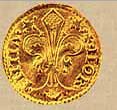Fiorino
The Italian fiorino was a coin struck from 1252 to 1533 with no significant change in its design or metal content standard. It had 54 grains of nominally pure (‘fine’) gold (3.5g, 0.1125 troy ounce) worth approximately 200 modern US Dollars. The “fiorino d’oro” of the Republic of Florence was the first European gold coin struck in sufficient quantities to play a significant commercial role since the seventh century. As many Florentine banks were international supercompanies with branches across Europe, the florin quickly became the dominant trade coin of Western Europe for large scale transactions, replacing silver bars in multiples of the mark (a weight unit equal to eight troy ounces).
In the fourteenth century, a hundred and fifty European states and local coin issuing authorities made their own copies of the florin. The most important of these was the Hungarian forint because the Kingdom of Hungary was a major source of gold mined in Europe (until the New World began to contribute to the supply in the sixteenth and seventeenth centuries, most of the gold used in Europe came from Africa).
The design of the original Florentine florins was the distinctive fleur de lis badge of the city on one side and on the other a standing facing figure of St. John the Baptist wearing a hair shirt. On other countries’ florins, first the inscriptions were changed (from “Florentia” around the fleur, and the name of the saint on the other), then local heraldic devices were substituted for the fleur de lis.
Usually later, other figures were substituted for St. John. On the Hungarian forints, St. John was re-labelled St. Ladislaus, an early Christian King and patron saint of Hungary, and a battle ax substituted for the original’s sceptre. Gradually the image became more regal looking.
The weight of the original fiorino d’oro of Florence was chosen to equal the value of one lira (i.e. a nominal pound of 240 inflated denari) in the local money of account in 1252. However, the gold content of the florin did not change while the money of account continued to inflate; by 1500, a florin was worth seven Florentine lire. The values of other countries’ money continually varied against each other, reinforcing the florin’s utility as a common measure of value for foreign exchange transaction
The golden florin of the Republic of Florence was the first European gold coin struck in sufficient quantities to play a significant commercial role since the seventh century. As many Florentine banks were international companies with branches across Europe, the florin quickly became the dominant trade coin of Western Europe for large scale transactions, replacing silver bars in multiples of the mark (a weight unit equal to eight ounces).

